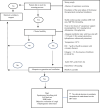Utilization of spontaneous breathing trial, objective cough test, and diaphragmatic ultrasound results to predict extubation success: COBRE-US trial
- PMID: 37908002
- PMCID: PMC10617213
- DOI: 10.1186/s13054-023-04708-y
Utilization of spontaneous breathing trial, objective cough test, and diaphragmatic ultrasound results to predict extubation success: COBRE-US trial
Abstract
Background: The results of clinical and weaning readiness tests and the spontaneous breathing trial (SBT) are used to predict the success of the weaning process and extubation.
Methods: We evaluated the capacity of the cuff leak test, rate of rapid and shallow breathing, cough intensity, and diaphragmatic contraction velocity (DCV) to predict the success of the SBT and extubation in a prospective, multicenter observational study with consecutive adult patients admitted to four intensive care units. We used receiver operating characteristic (ROC) curves to assess the tests' predictive capacity and built predictive models using logistic regression.
Results: We recruited 367 subjects who were receiving invasive mechanical ventilation and on whom 456 SBTs were performed, with a success rate of 76.5%. To predict the success of the SBT, we derived the following equation: (0.56 × Cough) - (0.13 × DCV) + 0.25. When the cutoff point was ≥ 0.83, the sensitivity was 91.5%, the specificity was 22.1%, and the overall accuracy was 76.2%. The area under the ROC curve (AUC-ROC) was 0.63. To predict extubation success, we derived the following equation: (5.7 × SBT) + (0.75 × Cough) - (0.25 × DCV) - 4.5. When the cutoff point was ≥ 1.25, the sensitivity was 96.8%, the specificity was 78.4%, and the overall accuracy was 91.5%. The AUC-ROC of this model was 0.91.
Conclusion: Objective measurement of cough and diaphragmatic contraction velocity could be used to predict SBT success. The equation for predicting successful extubation, which includes SBT, cough, and diaphragmatic contraction velocity values, showed excellent discriminative capacity.
Keywords: Airway extubation; Cough; Diaphragm; Mechanical ventilation.
© 2023. The Author(s).
Conflict of interest statement
The authors declare that the research was conducted in the absence of any commercial or financial relationships that could be construed as a potential conflict of interest.
Figures




References
-
- Melsen WG, Rovers MM, Groenwold RH, Bergmans DC, Camus C, Bauer TT, Hanisch EW, Klarin B, Koeman M, Krueger WA, et al. Attributable mortality of ventilator-associated pneumonia: a meta-analysis of individual patient data from randomised prevention studies. Lancet Infect Dis. 2013;13(8):665–671. doi: 10.1016/S1473-3099(13)70081-1. - DOI - PubMed
-
- Marinaki C, Kapadochos T, Katsoulas T, Rubbi I, Liveri A, Stavropoulou A, Bonacaro A, Papageorgiou D. Estimation of the optimal time needed for weaning of Intensive Care Unit tracheostomized patients on mechanical ventilation. A prospective observational study. Acta Biomed. 2023;94(2):e2023103. - PMC - PubMed
-
- Girard TD, Alhazzani W, Kress JP, Ouellette DR, Schmidt GA, Truwit JD, Burns SM, Epstein SK, Esteban A, Fan E, et al. An Official American Thoracic Society/American College of Chest Physicians Clinical Practice Guideline: Liberation from Mechanical Ventilation in Critically Ill Adults. Rehabilitation Protocols, ventilator liberation protocols, and cuff leak tests. Am J Respir Crit Care Med. 2017;195(1):120–133. - PubMed
Publication types
MeSH terms
Grants and funding
- 335980763260/Ministerio de Ciencia Tecnología e Innovación
- 335980763260/Ministerio de Ciencia Tecnología e Innovación
- 335980763260/Ministerio de Ciencia Tecnología e Innovación
- 335980763260/Ministerio de Ciencia Tecnología e Innovación
- 335980763260/Ministerio de Ciencia Tecnología e Innovación
- 335980763260/Ministerio de Ciencia Tecnología e Innovación
- 335980763260/Ministerio de Ciencia Tecnología e Innovación
- 335980763260/Ministerio de Ciencia Tecnología e Innovación
- 335980763260/Ministerio de Ciencia Tecnología e Innovación
- 335980763260/Ministerio de Ciencia Tecnología e Innovación
- 335980763260/Ministerio de Ciencia Tecnología e Innovación
- 335980763260/Ministerio de Ciencia Tecnología e Innovación
- MED-253-2019/Universidad de La Sabana
- MED-253-2019/Universidad de La Sabana
LinkOut - more resources
Full Text Sources
Medical

